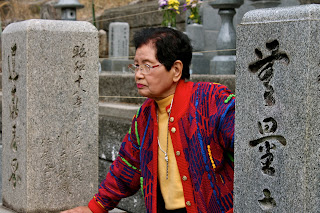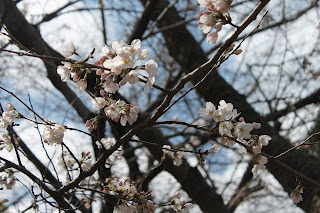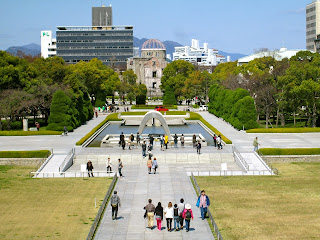
Thursday, April 25, 2013
Shopping in Nampo-Dong

Monday, April 15, 2013
Our Honeymoon Story on Traveler's Joy
Last year, Tyler and I decided to sign up with a honeymoon registry for our wedding since we were going to be traveling abroad for several years. We registered with Traveler's Joy, a reliable online company that made it easy for family members and friends to read (here) about our story and our honeymoon plans. In January, Traveler's Joy launched a honeymoon story writing contest. Yesterday, they announced the winners on their Facebook page. Unfortunately, we were the runners-up and barely missed out on $500 worth of hotel credit! Oh well... I suppose we should be proud of second place out of over five hundred entries! Although we didn't win, our story is being featured on www.travelersjoy.com. You can read it (here) to find out more about our beautiful honeymoon in Bali!

Tuesday, April 9, 2013
Announcement: Alaska!
Well, we received the contract this morning which makes it official. This August, we're moving to Alaska!
Deciding where to go next year was very difficult. We considered Abu Dhabi, Eastern Europe, Japan, and other Asian countries. However, after several months of job hunting, email sending, researching, and weighing our options, Alaska became our destination of choice.
Although many wouldn't consider living in Alaska to be a foreign experience, I am expecting to go through more culture shock there than I have in South Korea. We're moving to a native village. That's code for the bush, or where men hunt, wear flannel, and grow gnarly beards.
We are moving to a town called Newhalen. Below are some facts about the place we will soon call home:
- Newhalen is only accessible by small plane (a 1-hour ride from Anchorage)
- Newhalen is located on the north shore of Iliamna Lake
- The population is 182
- 95% of the population is made up of Yup'ik, Alutiiq, and Athabascan Eskimos
- Thousands of sport fishermen visit the area every summer for trophy rainbow trout fishing
- In the district, Grizzly Bears outnumber people
Above: An aerial shot of Newhalen
South Korea has provided us with so many incredible experiences and opportunities. However, we're excited to move to a place where the pace of life is slower. Busan is a bustling city and people are always on the go. In Newhalen, we'll be forced not to go anywhere.
We can't wait to embark on this journey. Until then, though, we have many more adventures still to be had here during our last four months in Korea! Thank you all for staying up to date with our travels.

Thursday, April 4, 2013
Hiroshima: Part 2
After our first day and a half in Hiroshima, we were buzzing with good vibes. Even though we left the Hiroshima Peace Memorial Museum in gloomy moods, spending time cruising the city with my dad and my husband cheered me up immediately. You couldn't have found a happier girl. Japanese sunshine, delicious sushi, and ice cream on the canal all framed by the emerging cherry blossoms made for an incredibly sweet time.
Just when I thought our trip couldn't get any better, my Japanese family members showed up at the hotel the next morning with bright smiles and high spirits. My Obaasan (grandma), Uncle Paul, Cousin Wendy, Cousin Chris, and Cousin Jeannie came from California and Hawaii to retrace our family roots in Hiroshima. My Obaasan spent part of her childhood in a town close to Hiroshima and was so excited to be back in the place of her family's birth.
After everyone settled in at the hotel, we all traveled by ferry to Miyajima, also known as the Shrine Island.
On the ferry, we saw beautiful views of the famous torii gate. The gate was part of the Itsukushima Shrine which was first constructed in the 6th century. It was dedicated to the three daughters of the Shinto deity of the seas and storms. Since the shrine and the island itself are considered sacred, no commoners were allowed to visit throughout much of its history. The shrine was built like a pier over the water to create a barrier between the sacred and the profane. Those who sailed to the island had to navigate through the torii gate in order to arrive at the shrine.
Here, you can see the torii gate in the distance from the ferry.
Once we arrived at Miyajima, we ate a delicious udon/soba lunch before we started the walk around the island. The circular island path was framed by all kinds of souvenir shops, restaurants, and coffee shops. My Cousin Wendy bought us all Momiji Manju, maple-leaf-shaped cake filled with mashed sweet bean paste, to eat as we walked. Tyler and I ran up a hill to survey the momentous structure pictured above. The Senjokaku Shrine, also known as The Hall of a Thousand Tatami Mats, was built in 1587 by a Japanese warlord as a place to hold sutra-chanting in honor of war casualties.
Another funny thing about the island is that Japanese deer, also called Nihonjika, were everywhere! They acted more like pet dogs than they did like deer. They were so "friendly" with people that they could be regularly seen chasing down an innocent child holding a bag of food. We saw a poor guy munching on french fries get accosted by about six deer.
The traditional rice scoop that comes from Miyajima, called the Miyajima Shakushi, was featured in every shop window. Towards the end of our walk, we came upon a giant Miyajima Shakushi on display. When Tyler saw it, he exclaimed, "The world's largest ping-pong paddle!"
The next day, we were all in for a special treat. My grandma's cousins came to the hotel at 10:00am to pick us up and take us to Kamifukawa, my family's hometown in Japan. My grandma stayed in Kamifukawa for a year when she was in elementary school and only has fond memories and happy stories to tell about her time. After we all packed into two large vans, we headed to the cemetary where my grandma's grandfather is buried. The stone marker above features the family name, Kawate, and is the grave of my great-great-grandpa. The photo to the right is a picture of the most adorable little girl on the planet named Ai (meaning "love" in Japanese). She's my grandma's cousin's granddaughter, which I believe makes her my third cousin.
My grandma's closest cousin, Toyoko, stood next to the grave markers and shared history in Japanese. She was a fountain of knowledge and recounted many stories of my great-great-grandparents. We were all able to find out a great deal about our family history.
On a more sorrowful note, Toyoko later shared with us her own experience in the 1945 atomic bomb. Toyoko was only 17-years-old when the bomb detonated. She had traveled from Kamifukawa to Hiroshima to work in the city. She was only 2 kilometers away from the epicenter when she saw and heart the blast. Toyoko rolled up her sleeve to reveal a patch of flash burns that she incurred at the moment of the explosion. She said that her hair was singed, her clothes were falling off, and she was scorched from head to toe. Her shoes were so burnt that she took them off, left them behind, and walked many miles from Hiroshima to her home.
Having a family member tell such a powerful story really hit home. The atrocities of nuclear weapons became so real to me after hearing from Toyoko and visiting the memorial museum.
It was so neat witnessing my family members discuss and try and figure out our family history. I learned a great deal not only about our lineage, but about the Japanese culture and the traditions of family life. My Cousin Chris has been piecing together parts of our family history puzzle for years now and recorded a great deal of important information from our time at the cemetary.
After we left the cemetary, we visited our family house built by my great-grandfather. The house is used for the sole purpose of family gatherings.
Our generous family members served us green tea and a cracker-like snack. We sat around two tables talking and enjoying the company of new family members.
My Obaasan, pictured above, was so happy and content to be reunited with her cousins in a place she had visited so long ago. She was beaming the entire time!
To end our beautiful day, we went to a delicious traditional Japanese restaurant. Obaasan, Toyoko, and I ordered bento boxes with soup, rice, vegetables, tofu, and tempura. Just look at those two gorgeous ladies in the photo above. Can you believe that they're in their late 80's? Man, I have some good genes.
Our time in Japan was one of the most special and memorable trips I've ever had. I still can't believe that I was able to visit the place where my family originiated from and connect with so many of my native Japanese relatives. During this trip, I realized the significance of tracing family history. Knowing the details of where you came from provides so much insight into your self-identity. I know that I am going to preserve the tradition of honoring our family's cultural identity for many years to come and one day share it with my own children.

Monday, April 1, 2013
Hiroshima: Part 1
A second trip to Japan...
We arrived a week before the climax of the Cherry Blossom seasons. They had just begun their primaveral wakening, sleepy and scant on the branches but with promise to come.
Our flight was an hour long and we took the subway to the Shinkansen, aka "The Bullet Train." The train was spacious (even by the standards of my long legs) and naturally very fast. If I remember correctly it moves at something like 188mph. Most seats were occupied by men in business suits drinking beer and laughing and chatting together - presumably an indicator of a good week of business abroad.
We got into Hiroshima at 9pm, and took a taxi ride 1 block from the station to the hotel (we weren't sure where it was), much to the laughter of the taxi driver and Natalie and I. "Ok, here we are," he said. "I'm sorry, what?"
It was very surreal, but equally wonderful, to see Mark in Japan. We were all very hungry, so we went to a small sake restaurant that become our late evening haunt the rest of the trip. We ordered Chicken Teriyaki (how could one resist in Japan), a mustard chicken dish, sashimi, a grilled veggie plate, and perhaps another dish or two that escapes my memory. In short, we ate our fill. Their sake list was extensive and included perhaps 10 locally brewed sakes. The meal and the drinks were delicious and lived up to every bit of the expectations of our previous trip to Japan. The fact that we were their with Mark catching up, talking about life and laughing, was all the more memorable.
I got the distinct feeling this time, as well as every other time I went there, that the server had a particular dislike for me. Mark and I attempted to analyze his behavior with myself vs. the other customers for clues. Our results were inconclusive.
Thursday, our first full day there, was very fun but very heavy. Below is our taking the above ground trolley to the A-bomb dome.
Below is the A-bomb dome. In the city center, it is probably the most well "preserved" building after the bomb hit. It lays within 100 meters or so of the A-bombs hypocenter (the spot directly below impact). What is especially startling about this building is comparing its current state to it original majesty - it was a splendid exhibition hall. Everyone in the building died. Seeing the skeleton, twisted remains of the circular staircase was very eerie. To think feet and toes and shoes just as our own once carried their lives and memories up those now-rusty stairs, is quite eerie.
Though you cannot ascertain it in this picture, from where this photo was taken to the A-bomb dome (seen towards the back of the shot, just on the other side of the trees) is probably 400 meters long. The stone arc on the photo-side of the pond is an epitaph for the people that died in the bombing. It's quite a beautiful construction actually, with the veranda at the very center of the A-bomb museum (i.e. where this shot was taken) aligning perfectly with the A-bomb dome, pond, and epitaph.
The below two models, which are each perhaps 10m in diameter, really put into perspective exactly how destructive the A-bomb was. The A-bomb exploded about 600m above ground and within a second and a half erased most of the city, as you can see.
It's eerie to think people were going about their normal days, perhaps worrying about normal things. Some were irritated because they were waiting in line, others wondering what they were going to have for breakfast, many were headed to or had just arrived at work.
Perhaps the eeriest part of the whole museum (if one can even categorize such horrors) to me was this watch. They had several such relics, that stopped at exactly 8:15, the time when the bomb hit. Everything stopped then for the people of Japan.
A great many of those who died in the blast were children. They worked at the mines and shops to help the war effort. Look was the A-bomb did to their close, and it's not hard to imagine what such force does to one's skin. The exhibit was filled with countless pieces of clothing, hair, skin, melted tricycles, children's toys, shoes, finger nails, giant chunks of scarred skin, working equipment distorted by the heat, and one giant stone slap where one man's shadow was permanently ingrained in the rock - the rock surrounding his body was bleach by the heat. It was to say the least, overwhelming.
After the bomb went off, a great majority of people had severe 4th degree burns (many water blisters all over their body and black crusted skin) or even worse the skin simply melted away from their body and lay in hanging tatters from their bones. After that it seems that everyone spontaneously had the same thing to do: walk home. Many of the people walked home half naked and with melted shoesand on the verge of death, and then died later that night or the next day. It is a gruesome sight to imagine, those thousand of people quietly marching half burned, half melted, back to their homes. Some of the walks were miles long.
As I think most of us know, the affects of the bomb pervaded well into the future, in the form of cancers and horrendous deformities in the children of those affected.
The paper crane (and their must have been countless thousands, some of which surely were made with needles) exhibit on the grounds of the park. Started by Sadako who was infected with cancer from the radiation, and began making the cranes in hopes of curing herself.
Later that evening, we went to a district in Japan known for its neon lights and abundant sources of food. It was fabulous to see (what I consider to be) traditional Japanese paper lanterns giving a ghostly luminance to the doorsteps of restaurants. It was very serene.
We walked up and down the entire main drag of the the district. Along the way I saw a Japanese liquor store. Because I had not tried any good Japanese Whiskey for myself, one of my goals for the trip was to find a good Whiskey and try it out. I bought a Yamazaki 10 year for about $35. I was impressed. For a medium grade Whiskey (about what you would pay for a Maker's Mark in the states) I found it to quite a bit better quality for what you pay.
We also stopped by a large gaming arcade of sorts. They had many claw machines, just like home, but in this case they featured some items that one would not ordinarily expect to see, well, anywhere. Below for example, is a large...uh hat? and, uh, face scarf?
We eventually found a small hole in the wall sushi restaurant with top quality sushi. It was obviously fresh and was exceedingly delicious. Whether it was just being in Japan, or was simply the quality of the food itself, and I guess that both factors contribute, it was some of the best sushi I've had. The tuna was exquisite. Next to us were three business men who, no joke, must have ordered three times as much food as us, and were still going strong when we left.
We packed a lot into the first day but it was very memorable. Between the A-bomb museum, spending time with Mark in Japan for the first time, and then exploring the city and capping the night of with a Whiskey and fabulous Sushi, I couldn't have hoped for a more satisfying day.

Subscribe to:
Posts (Atom)























































